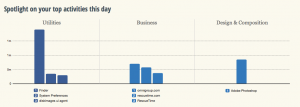Productivity is supposed to just be a handy single word to cover all the things we want to do. But it becomes a label and then it becomes an ideal and you can see people for whom the word itself has become a cult. If you spend more time thinking about productivity than actually doing anything, you need help.
Hello. My name is William.
(Hello, William!)
The ease with which we can get caught up in shaving a few seconds off those tedious emails, in making sure our work is everywhere we are so we can get right down to it and finish that vital paragraph on the train, in writing sentences so long that you’ve forgotten the start… um… The ease with which we get caught up like that is one reason I think it feels so bad when we stop. When you fall off the productivity line, it’s rarely because you’ve made a conscious choice to get a life. It is usually that you didn’t keep up the effort. That feels bad enough but then these things snowball and you just see all the jobs you’ve got to do mounting up and mounting up. Perhaps because you have been on top of it all, you can see how big that mountain really is and that makes it even harder to get back going again.
Bollocks to mountains.
Do you know the phrase ‘sunk cost’? It’s the money you’ve already put into something. If you’ve invested £50,000 in something that isn’t working, it’s ferociously hard to forget that £50,000 and move on. Of course it is. It’s bleedin’ £50,000. Yet sometimes you should weep now and move on, sometimes it is a sunk cost. Because we are so wired to feel the loss of that £50,000 that if someone says you just need to do this simple thing – oh, and it only costs £20,000 more – we think about it. So we should: I’m not saying investors should bail out early, though you know how every website gives financial advice like that and then says, by the way, nobody here knows anything so you can’t sue us? Seriously, I know nothing about investing. I’m making an analogy. You knew that but I had to say it. Anyway. This £20,000 more lark: we don’t see the £20,000 because we’re still blinded by the enormity of the £50,000 we’ve lost. There’s a very good chance that we will spend that extra £20,000 because of it.
And then we’re out by £70,000.
Sometimes you must, you must accept that the money and the time and the sweat you put in to something is gone, it is this sunk cost and nothing you do will bring it back, maybe everything you can do will make it worse. Except moving on.
If you’ve fallen off the productivity line, forget everything that’s behind you. Yes, you failed to complete this important thing, yep you should’ve done that other vital thing. But you did fail and you didn’t do what you should.
Let it go because it is already gone.
Bollocks to all of it, there is literally nothing you can do to fix it so move on and put all that energy into doing the next thing instead. Some problems will cause you damage forever but not actually that many and most things you didn’t do today will be forgotten by everyone else by tomorrow, so join them. Forget it. Move on.
If you really are in a bad place and it really does seem like a mountain that is resting on your chest, do take a look at Bad Days in my book The Blank Screen (UK edition, US edition).
But also just take a breath. Look at what’s in front of you right now and see what tiny bit of it you can actually do, right now.
Don’t look down, don’t look up, just chip away in small moves and I promise they add up to mountains. And if that’s too Hallmark Card-like for you, think of it this way: maybe small moves don’t add up very quickly or to very much, but they add up to a hell of a lot more than your sitting there doing nothing but regretting mistakes.

